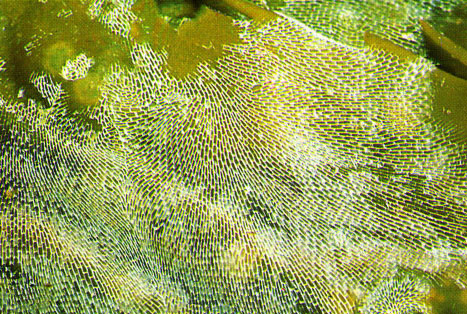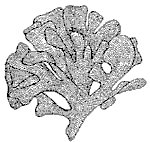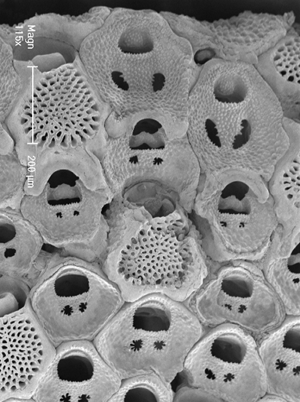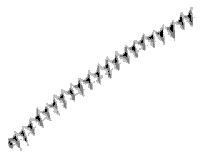
| Palaeos: |  |
Bryozoa |
| Bryozoa | Bryozoa |
| Page Back | Unit Back | Metazoa | Metazoa Dendrogram | Metazoa References | Taxon Index | Pieces |
| Page Next | Unit Next | Unit Home | Unit Dendrogram | Unit References | Glossary | Time |
 The encrusting bryozoan, Membranipora membranacea; Gymnolaemata > Cheilostomida > Membraniporidae. The encrusting habit is characteristic of many bryozoa, although some have erect colonies that resemble miniature corals. Bryozoa are commonly encountered even in intertidal rockpools, or found cemented on other organisms such as kelp or seashells. Image from: USGS, via Wikipedia, public domain |
Bryozoans, or "moss animals," are aquatic, mostly marine, colonial organisms, superficially rather like coral. A few to many millions of these individuals may form one colony. The colonies range from millimeters to meters in size, but the individuals that make up the colonies are tiny; usually less than a millimeter long. Usually they encrust rocky surfaces, shells, or algae. The colonies may be soft-bodied or calcareous like corals. It is the latter that are most often fossilized. There are about 5000 living species, with several times that number of fossil forms known.
 After
approximately 250 years of scientific study, the sum total of accumulated human
wisdom on the subject of bryozoan phylogeny is Nil. Zero.
Nada. It would be fair to state that we know as much about the phylogeny
of entirely hypothetical Martian cryptobionts. Those, at least, have been
the subject of intense speculation by learnèd folks who can get away with such
speculations in the semi-popular press. Bryozoologists just throw their
hands up -- like so many zoöids waving their happy lophophores about.
Maybe they'll catch onto something that way -- but we are not
optimistic.
After
approximately 250 years of scientific study, the sum total of accumulated human
wisdom on the subject of bryozoan phylogeny is Nil. Zero.
Nada. It would be fair to state that we know as much about the phylogeny
of entirely hypothetical Martian cryptobionts. Those, at least, have been
the subject of intense speculation by learnèd folks who can get away with such
speculations in the semi-popular press. Bryozoologists just throw their
hands up -- like so many zoöids waving their happy lophophores about.
Maybe they'll catch onto something that way -- but we are not
optimistic.
For taxonomic purposes, the Bryozoa are classified as follows:
PHYLUM BRYOZOA
Class Stenolaemata
Order Cyclostomata
Order Hederellida
Order Trepostomatida
Order Cystoporida
Order Cryptostomida
Order Fenestrida
Class Gymnolaemata
Order Ctenostomata
Order Cheilostomata
Class Phylactolaemata
MAK990511 ATW050910.
The following phylogeny is proposed by Palaeos contributer Christopher Taylor on the basis of Prothero, 1998. and should not be considered more authoritative than other phylogenies (assuming their are any). We have only included here because what would Palaeos be without its dendrograms? MAK121001
Bryozoa
|--Ctenostomata
`--+--Cheilostomata
`--+-- Stenolaemata
`-- Phylactolaemata
 Scanning electron micrograph of part of a bryozoan colony showing male and female brooding zooids and feeding autozooids.. © 2008-2010 Australian Institute of Marine Science, Creative Commons Attribution license |
These are marine bryozoans with tubular zooids with strongly calcified walls. The lophophore is protruded by action of annular muscles. Most forms lack an operculum. This was the predominant Bryozoan group during the Paleozoic. Some grew as lacy or fan-like colonies that became important reef builders and in some regions form an abundant component of limestones. Their numbers were greatly reduced by the terminal Permian extinction event.
Bryozoa with encrusting or erect colonies, many with communication pores. The skeletal structure is typically laminated. The aperture for each zooid (little animal) is either circular or polygonal. Late Ordovician to Recent. - about 250 genera
| Representative types | Systematic Classification |
|
|
SUBORDER PALEOTUBULIPORINA
SUBORDER TUBULIPORINA SUBORDER FASCICULINA SUBORDER ARTICULINA SUBORDER CANCELLATA SUBORDER CERIOPORINA SUBORDER RECTANGULATA |
A group of bryozoans similar to cyclostomatids; of uncertain relationships. Late Ordovician to Carboniferous.
Colonies generally robust; dendroid, encrusting, or massive. Ordovician
to Triassic - 200 genera
![]()
![]() Tabulipora
acadica - (Family: Stenopridae) - Early Carboniferous of Nova Scotia
Tabulipora
acadica - (Family: Stenopridae) - Early Carboniferous of Nova Scotia
Colonies encrusting or erect, robust or delicate. Crescent-shaped thickened strip or projections (lunarium) around each aperture. Early Ordovician to Late Permian - 100 genera
| Representative types | Systematic Classification |
|
|
SUBORDER CERAMOPORINA
SUBORDER FISTULIPORINA |
Colonies erect, typically delicate; foliate, dendroid.(tree-like), or bilaminar
sheets. Skeletons without communication pores
Early Ordovician to Late Permian - 90 genera
| Representative types | Systematic Classification |
|
|
SUBORDER PTILODICTYINA
SUBORDER RHABDOMESINA SUBORDER TIMANODICTYINA SUBORDER GOLDFUSSITRYPINA SUBORDER STREBLOTRYPINA |
Includes some of the most amazing bryozoa. The colonies are erect,
typically delicate; reticulate (net-like) or pinnate (fern-like).
This order was previously included under the Cryptostomata.
Early Ordovician to Late Permian - 100 genera
Representative types
 |
 |
| close up | entire colony |
| Family Archimedes wortheni Hall Early Carboniferous (Warsaw Formation - Early Visean, Arundian epoch) west Laurussia |
|
Mostly marine bryozoans with cylindrical or flattened zooids. Lophophore is protruded by action of muscles pulling on frontal wall. Includes the majority of living bryozoan species..
Uncalcified forms, including several that bore into calcareous substrates. Skeleton membranous or gelatinous. Opercula rare. Eggs brooded in body cavity. Almost all fossils are traces of boring forms Ordovician to Recent - 50 named genera
| Representative types | Systematic Classification |
| Suborder STOLONIFERINA
Superfamily TEREBRIPOROIDEA family VINELLIDAE Vinella repens Ulrich, 1890 (above) Blackriveran (Sandbian) North America width of shell illustrated on top right: 3 cm (from the Union College Geology Department site)
|
SUBORDER ALCYONIDIINA
SUPERFAMILY ALCYONIDIOIDEA SUBORDER FLUSTRELLIDRINA
SUBORDER VICTORELLINA
SUBORDER PALUDICELLINA
SUBORDER VESICULARINA
SUBORDER STOLONIFERINA
|
These are calcified forms, usually with an opercula. Short-box-like zooeica
(chambers for the little animal). The eggs are usually brooded in
ovicells (swollen spherical chambers in which the fertilized egg develops
into a larva). The suborders are distinguished according to frontal
calcification and mechanism of lophophore protrusion. This order includes
the majority of recent Bryozoa
Late Jurassic - Recent. 1000 genera
| Representative types | Systematic Classification |

Infraorder FLUSTRINA Superfamily CALLOPOROIDEA family Flustridae (Flustra foliacea Linnaeus, 1758) (Recent - Europe and the Arctic)
|
SUBORDER PROTOCHEILOSTOMATINA
SUPERFAMILY LABIOSTOMELLOIDEA SUBORDER INOVICELLINA
SUBORDER SCRUPARIINA
SUBORDER MALACOSTEGINA
SUBORDER NEOCHEILOSTOMINA
SUBORDER ASCOPHORINA
|
Non-calcareous freshwater bryozoans with no zooid polymorphism. Horse-shoe shaped lophophore.. No fossil record except for a few statoblasts (resistant wintering structures) from Quaternary sediments.
| Representative types | Systematic Classification |
|
|
ORDER PLUMATELLIDA |
illustrations from the former The "Lesser" Protostome and Lophophorate Phyla page at University of Sydney Biological Sciences, from Brusca and Brusca, Invertebrates.1990.
Prothero, D. R. 1998. Bringing Fossils to Life: An introduction to paleobiology. WCB McGraw-Hill: Boston.
![]()
![]()
![]() The
Bryozoa Home age - Recent and Fossil Bryozoa
The
Bryozoa Home age - Recent and Fossil Bryozoa
![]() Introduction
to the Bryozoa - "Moss animals"
Introduction
to the Bryozoa - "Moss animals"
| Page Back | Page Top | Unit Home | Page Next |